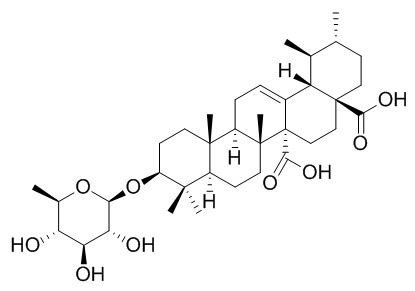Quinovin
Quinovin glycoside has cytotoxicity.
Inquire / Order:
manager@chemfaces.com
Technical Inquiries:
service@chemfaces.com
Tel:
+86-27-84237783
Fax:
+86-27-84254680
Address:
1 Building, No. 83, CheCheng Rd., Wuhan Economic and Technological Development Zone, Wuhan, Hubei 430056, PRC
Providing storage is as stated on the product vial and the vial is kept tightly sealed, the product can be stored for up to
24 months(2-8C).
Wherever possible, you should prepare and use solutions on the same day. However, if you need to make up stock solutions in advance, we recommend that you store the solution as aliquots in tightly sealed vials at -20C. Generally, these will be useable for up to two weeks. Before use, and prior to opening the vial we recommend that you allow your product to equilibrate to room temperature for at least 1 hour.
Need more advice on solubility, usage and handling? Please email to: service@chemfaces.com
The packaging of the product may have turned upside down during transportation, resulting in the natural compounds adhering to the neck or cap of the vial. take the vial out of its packaging and gently shake to let the compounds fall to the bottom of the vial. for liquid products, centrifuge at 200-500 RPM to gather the liquid at the bottom of the vial. try to avoid loss or contamination during handling.
Chinese Journal of Hospital Pharmacy2020, 40(7)
Phytochemistry Letters2015, 243-247
Plant Foods Hum Nutr.2021, 76(4):472-477.
Food Chem.2019, 279:80-87
Molecules.2023, 28(18):6734.
J Int Med Res.2021, 49(7):3000605211032849.
Molecules.2019, 24(17):E3127
Kangwon National University2022, 37(1):29-37
Food Chem.2017, 221:1135-1144
Nutrients.2020, 12(12):3638.
Related and Featured Products
Archives of Pharmacal Research, 2002, 25(3):270-274.
Structure-activity relationship of triterpenoids isolated fromMitragyna stipulosa on cytotoxicity.[Reference:
WebLink]
METHODS AND RESULTS:
Chromatographic separation of the stem bark extract ofMitragyna stipulosa afforded triterpene derivatives ursolic acid (1), quinovic acid (2), quinivic acid 3-0-β-D-glucopyranoside (3, Quinovin glycoside C), quinovic acid 3-0-[(2-0-sulfo)-β-D-quinovopyranoside] (4, zygophyloside D) and quinovic acid 3-0-β-D-quinovopyranosyl-27-0-β-D-glucopyranosyl ester (5, zygophyloside B). These five compounds were subjected to the cytotoxicity on MTT assay system. Compound1 among tested showed the most potent cytotoxicity. Quinovic acid showed less potent cytotoxicity than ursolic acid and sugar linkages to2 decreased the cytotoxicity. Compound4 more potent than3 with indicate that the sulfonyl group significantly enhances the activity.
CONCLUSIONS:
This indicates that the glycosidic linkage in ursane-type triterpenoids has mainly negative effect on cytotoxicity unlike in oleanane-type glycosides.



